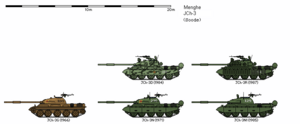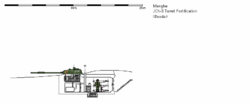JCh-3
| JCh-3 | |
|---|---|
 | |
| Type | Medium Tank |
| Place of origin | |
| Service history | |
| In service | 1960-present |
| Used by | |
| Production history | |
| Manufacturer | Inmin-Chŏlgang-Nodongja Vehicle Plant (former) Chikai Inmin Jŏncha Gongjang (former) |
| Produced | 1965-1988 |
| No. built | 32,000 |
| Variants | JCh-3G, JCh-3N, JCh-3N1, JCh-3D, JCh-3R, JCh-3HB |
| Specifications (JCh-3N) | |
| Weight | 35 metric tonnes |
| Length | 10.41 m (inc. gun and fuel drums) |
| Width | 3.35 m |
| Height | 2.41 m to turret roof |
| Crew | 4 (driver, gunner, commander, loader) |
| Armor | welded steel plate Turret face: 210mm Glacis plate: 100mm at 55 degrees |
Main armament | 100mm JP-10TL |
Secondary armament | 12.7mm DSK HMG (commander’s cupola) 7.62mm DP-47 machine-gun (co-axial) |
| Engine | 12-cylinder diesel 550 hp |
| Power/weight | 15.7 hp/tonne |
| Suspension | torsion-bar |
| Ground clearance | 45 cm |
Operational range | 400 km |
| Speed | 50 km/h (road) |
The JCh-3 (Formal designation: 3호 중형 전차 / 三號中型戰車, Sam-ho junghyŏng jŏncha, "No.3 Medium Tank;" short designation 전차-3, Jŏncha-sam) is a medium tank built in the Democratic People's Republic of Menghe and later in its successor state, the Socialist Republic of Menghe. In its original form, it was an almost exact copy of the T-58, designed in Letnia. Over the course of later upgrades and variants, it followed a separate development path from the T-58, culminating in what is essentially a separate family of tanks. It was produced in Menghe beginning in 1965, with the Inmin-Chŏlgang-Nodongja Vehicle Plant ending production in 1983 and the Chikai Inmin Jŏncha Gongjang ending production in 1992.
Today, the JCh-3 is no longer in service with the Menghean Army. It has been replaced by the JCh-4 and JCh-5. Its chassis, however, has been used as the basis for a number of other combat platforms, including the DGJP-230 and DGJP-422 self-propelled anti-air guns.
Description

The JCh-3 shares its predecessor’s conventional layout, with the driver in the front left, ammunition stowage in the front right, the turret in the center, and the engine in the rear. Within the turret, the gunner sits in the front left and the commander sits just behind him, with the loader seated on the right side of the gun. The driver, loader, and commander all have hatches above their seats, while the gunner must climb out through the commander’s hatch.
On early variants, the main armament was a 100mm rifled gun, coped from the Letnia's K-10TL. Thirty-eight rounds for this weapon were carried. The JCh-3G relied on a manual hand-crank system to elevate and depress the gun; JCh-3N added rudimentary vertical and horizontal stabilizers, as well as a powered elevation system. Elevation runs from -5 to +18 degrees. Secondary armament consists of a 7.62mm co-axial machine gun and a 12.7mm cupola machine gun for the commander. The latter is manually operated and lacks remote sights.
Like the T-58, the JCh-3 incorporates a rudimentary CBRN defense system to protect it in contaminated environments. Until the addition of a more reliable overpressure air pump in the JCh-3D, however, the opening of the casing ejection hatch violated the seal, and even after this adjustment crews were routinely trained to operate the vehicle while wearing bulky CBRN protection gear.
The armor consists of welded steel, and reaches the following thicknesses:
- Turret front: 210mm (rounded)
- Turret sides: 148mm (rounded)
- Turret rear: 80mm (rounded)
- Turret roof: 40mm (rounded)
- Hull front: 100mm (sloped at 55 degrees)
- Upper hull sides: 75mm (vertical)
- Lower hull sides: 20mm (vertical)
- Hull rear: 50mm (vertical)
- Underside: 20mm (horizontal)
- Hull roof: 30mm (horizontal)
Variants
JCh-3N
As described above, the JCh-3N was a minor indigenous upgrade of the JCh-3 design, identified mainly by the addition of side skirts and rear mounts for fuel drums. It also featured minor improvements to the searchlight used by the commander.
JCh-3D
A further upgrade, the JCh-3D, entered service in 1984. It was a major refit which sought to incorporate some of the improvements developed for the JCh-4 tank. These included an internally aimed GCh-75Ch heavy machine gun, a large infrared spotlight for the gunner, and improved radio communication equipment. The JCh-3D also added an applique-armor "horseshoe" over the turret face, improving protection over the frontal arc. An added plate welded atop the hull glacis had the same effect. Both of these appear to have used a spaced armor arrangement rather than true composite armor, though they are sometimes described as composite armor in Menghean sources. Less major improvements included smoke grenade projectors and a snorkel for river-fording operations.
JCh-3N1
The JCh-3N1 was a low-cost upgrade to JCh-3N hulls, first introduced in 1985. It lacked many of the newer features introduced on the JCh-3D, and was apparently intended as a more feasible choice for upgrades across Menghe's tank fleet. Applique panels on the turret were retained, though they were not present on the hull, and the tank's fire-control systems were unchanged with the exception of a new infrared searchlight for the commander.
JCh-3R
First seen in 1987, only a few months before the Decembrist Revolution, the JCh-3R was based on the JCh-3D but incorporated ERA blocks on the turret and hull. Menghean sources classify the protection used as "first-generation ERA," and note that it is only effective against simple shaped charges; it has no effect on tandem-charge warheads or kinetic energy penetrators.
Relatively few were built, and the post-coup government cancelled JCh-3 new-production, though it did authorize the conversion of existing JCh-3D hulls to JCh-3R levels of protection. Because the electronics are identical between variants, the upgraded hulls are functionally identical, but bear the designation JCh-3R1. A special 100mm gun-launched ATGM was considered for the design, but was ultimately rejected as a waste of development funds for a tank that would soon be retired.
JCh-3HB
In the early 1970s, the Democratic People's Republic of Menghe developed an armored flamethrower vehicle based on the JCh-3 medium tank. It uses the same hull and turret as the JCh-3N, but the main gun has been replaced by a high-pressure flamethrower capable of projecting burning fuel to a range of 240 meters. The vehicle is operated by a three-man crew; the loader's space on the right side of the turret and the ammunition stowage space to the right of the driver are replaced by stowage tanks for jellied fuel and compressed air. This allows enough fuel for about 90 seconds of continuous firing, after which a dedicated support truck can refill the tanks by means of a pipe run through the loader's hatch. At the time of the type’s introduction, the Menghe People’s Army also developed a matching fuel transport trailer, which could be towed in the Battalion’s logistics pool for refueling or attached directly to the tank and towed into battle for a larger ready fuel reserve. The latter approach was apparently discontinued in the mid-1980s, due to crew complaints that the trailer impeded mobility on rough terrain. Both the co-axial gun and the commander's machine gun are retained for defense against infantry once fuel is exhausted.
During the 1980s and 1990s, some JCh-3HBs were spotted with slat armor on the hull and turret, apparently part of an effort to improve protection against man-portable anti-tank weapons while assaulting infantry in entrenched positions. Vehicles refitted in this manner were designated JCh-3HB1.
According to state records, 210 vehicles of this type were produced. They were generally allocated with one or two 30-tank Battalions in each Field Army, as a separate asset which the General could use to reinforce breakthrough attacks. Within this total, three 10-vehicle Independent Tank Companies were transferred to the Marine Infantry, which could deploy them in support of a Brigade landing on a fortified beach. In 1989, two years after coming to power, the Menghean government announced that it would withdraw all flamethrower vehicles from active service. Nevertheless, in 2006 and 2008, JCh-3HBs were spotted on field exercises at the Jŏngsŏngrim training field, suggesting that at least some units were moved up to Mobilization Reserve status. The remainder have been scrapped, except for unit 633, which is on display at the National Armed Forces Museum in Chŏngsŏng.
Use as a coastal defense turret
In 2008, the Menghean Army unveiled a new type of coastal defense bunker using the turret of the JCh-3. In addition to the usual fighting compartment, which protrudes into the ground, there is also a compartment beneath containing a generator for the turret traverse and an adjacent room containing a small stove and bunks for the three turret crew (the driver, of course, is not included). Twenty-six shells are stored inside the turret and in racks around the fighting compartment, and up to 100 more can be stowed in a compartment under the floor of the main room. In a wartime scenario, the manned bunker could sustain itself with limited supplies, and it offers the crew better protection from artillery bombardment and aerial bombing than an open camp. Similar fortifications of this type existed from 1965 onward, but this appears to have been the first effort to create a standardized, modular design. In at least some emplacements, the turret may be covered in a plastic shell with the appearance of a rock, with the barrel concealed under loose leaves and grass at a low elevation.
It is not publicly known how many of these bunkers are scattered along the Menghean coastline, though some estimates suggest there may be upwards of a thousand. A few sites are open to tours by civilians. The turret itself is often fitted with a modified cupola that removes the commander's machine-gun and the all-round vision slots in favor of a single camera with high magnification capability and a thermal mode for nighttime engagements. Owing to the mediocre anti-armor performance of the 100mm rounds and the stationary placement of the turrets, it appears that they are mainly meant to fire on landing craft and amphibious APCs, as part of the Coastal Defense Forces’ strategy of inflicting heavy attrition during the landing stage.
Other variants
- JCh-3DS (Daedae Salyŏngcha): Battalion command vehicle with additional radio equipment and 5 fewer ammunition shells.
- JCh-3JGCh (Janggab Gunan Chalyang): Armored recovery vehicle with a crane, powered winch, and additional repair equipment.
Service
Though the T-58 was an adequate tank at the time of its introduction, future developments such as the advent of composite armor and larger-caliber smoothbore guns left it behind. Its thin steel armor was a particular problem, one which ERA applique kits could never fully solve. Nevertheless, its impressive reliability and low cost have allowed it to retain a long shelf life as a reservist weapon.
In 2013, the last regiment of JCh-3s in a Menghean Army mobilization reserve formation was removed from service, to be replaced with JCh-4s. According to some defense analysts, up to 1,000 may be in storage for use by the emergency reserves, mainly in units associated with the 2nd Coastal Defense Army. Of the vehicles removed from service, most have been scrapped altogether, while others have been re-used to form the hulls of self-propelled artillery and anti-aircraft weapons.
Users
 Qusayn: 320 purchased in 1970s, 205 still operational
Qusayn: 320 purchased in 1970s, 205 still operational
Former users:


